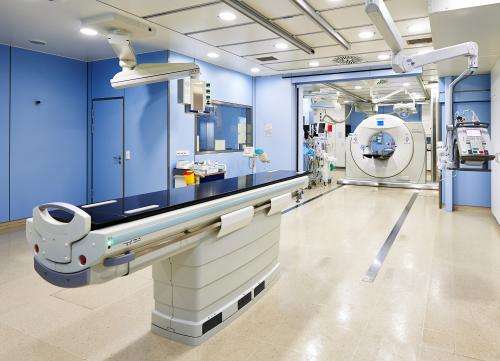Computer tomograph on rails

Siemens has installed a mobile, rail-mounted computer tomograph at Frankfurt University Hospital. The device can be used in two rooms: the room for routine scans and the trauma room. If necessary, the CT can be moved up to six meters on rails to take it from the routine scan room to the adjacent emergency room. The solution allows doctors to thoroughly examine severely injured accident victims in the trauma room without having to move them. But because such situations occur infrequently and cannot be planned in advance, the computer tomograph can also be used for routine examinations. This enables far more patients to be scanned, thus making the device's operation more cost-effective.
For some time now, the German Society for Trauma Surgery (DGU) has been demanding that whole-body CTs be available around the clock near trauma rooms. Until now, this wish was difficult to fulfill, because trauma room CTs are rarely used and therefore not economical. In addition, it is always risky to move trauma patients around. The installation from Siemens solves these problems.
To create the mobile CT, the experts at Siemens decided to use an enhanced sliding gantry. A CT's gantry consists of the entire rotating unit that contains the radiation source, the detector, and the associated electronics. Whereas conventional CTs have immobile gantries and the examination table moves along with the patient, a sliding gantry moves up to 120 millimeters per second while the patient remains stationary on the table.
What's new about the sliding gantry used in the mobile CT SOMATOM Definition AS is that the top-quality scanner moves on rails that are up to six meters long. The rails are completely submerged into the floor and covered by stainless steel strips so that staff members can walk on them without the risk of tripping. The CT's power cables, data lines, and cooling system are moved along a ceiling-mounted rail. A radio-opaque sliding door can be closed between the two rooms, each of which has its own examination table.
A crucial advantage of the sliding gantry solution is that severely injured patients requiring diagnostic CT scans don't have to be moved away from the medical systems and stabilization equipment in the trauma room. Polytrauma patien¬ts suffer from severe injuries to various parts of their bodies. Life-threatening injuries have to be identified as quickly as possible so that they can be treated first.
The sliding-gantry version of the SOMATOM Definition AS could also be used between other parts of a hospital, for example between the interventional CT room, trauma room, routine examination room, and hybrid operating room.
















